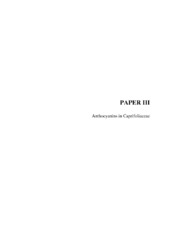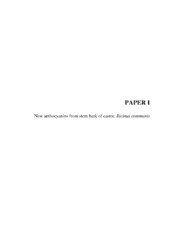| dc.contributor.author | Jordheim, Monica | eng |
| dc.date.accessioned | 2007-07-27T11:27:32Z | |
| dc.date.available | 2007-07-27T11:27:32Z | |
| dc.date.issued | 2007-06-22 | eng |
| dc.identifier.isbn | 978-82-308-0399-8 (print version) | en_US |
| dc.identifier.uri | https://hdl.handle.net/1956/2331 | |
| dc.description.abstract | This dissertation focuses on isolation and structural elucidation of anthocyanins, and their chemical properties. The characterization of anthocyanins from castor (Ricinus communis), fourteen cultivars of European gooseberry (Ribes grosssularia), three other Ribes spp., two cultivars of Jostaberry (R. × nidigrolaria), seven Hippeastrum (Amaryllis) hybridum cultivars, and nineteen species belonging to Caprifoliaceae (genera Sambucus, Lonicera and Viburnum) are described. New anthocyanins include: Cyanidin 3-O-β-xylopyranoside-5-O-β- glucopyranoside (11), cyanidin 3-O-β-xylopyranoside-5-O-β-(6'''-malonylglucopyranoside) (19) and the methyl esterified product (18), cyanidin 3-O-β-(6''-E-caffeoylglucopyranoside) (15), and cyanidin 3-O-β-(6''-α-arabinopyranosylglucopyranoside) (6), which is the first complete identification of the disaccharide vicianose. Pigment 15 together with cyanidin 3-O- β-(6''-E-caffeoylglucopyranoside) (17) constitute the major anthocyanin content in the cultivars; ‘Samsø’, ‘Hinnomäki Red’, ‘Taastrup’, ‘Lofthus’ and ‘Glendal’. These cultivars may thus be good candidates for consumption, colorant and breeding programmes, because no other commercial available berries have been reported to contain as high proportions of aromatic acylated anthocyanins. Anthocyanins from black beans (Phaseolus vulgaris) are for the first time hemisynthesized directly from a partly purified anthocyanin extract. The three mother anthocyanins (delphinidin 3-O-β-glucopyranoside (22), petunidin 3-O-β-glucopyranoside (26), malvidin 3-O-β-glucopyranoside (27)) and their hemisynthesis products, 5- carboxypyranoanthocyanins (32-34), were isolated in a preparative scale using Sephadex LH- 20 column chromatography. The individual pigments (22, 26, 27, 32–34) were characterized by NMR; the structures of 32 and 33 have previously only been tentatively identified. The 3-O-β-glucopyranosides of delphinidin, petunidin and malvidin (Phaseolus vulgaris) (22, 26, 27) and cyanidin 3-O-β-galactopyranoside (from Aronia melanocarpa) (4) have been dissolved in deuterated methanolic solutions without and with acid (5%, CF3COOD). Their hemiacetal (hemiketal) forms were characterized by NMR as two epimeric 2-hydroxy-hemiacetals. This is the first report of 13C NMR assignments regarding two epimeric anthocyanin hemiacetal forms. Displacement of nuclear hydrogen by deuterium at various sites on the aglycone part of delphinidin 3-O-β-glucopyranoside (22), petunidin 3-O-β-glucopyranoside (26), and malvidin 3-O-β-glucopyranoside (27) in their flavylium cationic and hemiketal forms were examined based on integration data obtained by 1H NMR spectroscopy. Similar measurements were performed on the three corresponding pyranoanthocyanins (32–34), and the flavonol rutin (quercetin 3-O-β-(6''-α-rhamnopyranosylglucopyranoside), 35. H→D exchanges were observed for the nuclear protons of the A-rings (H-6 and H-8) of 22, 26, 27 and 35. No similar H→D exchanges were observed for 32–34. This is explained with a generalized mechanism including a positively charged σ–complex. Since the oxygen (6-O) included in the pyrano-ring of 32–34, has not the same electron donating effect as the 5-OH group of 22, 26 and 27, the positively charged σ–complexes of 32–34 can not stabilize themselves to the same level as the corresponding complexes of 22, 26 and 27. The H→D exchange reactions appeared to be independent upon the concentration of the substrates and concentration of D+, in accordance with a first order reaction. Most antioxidant measurements are concentration dependent, and purity determination of examined compounds are crucial. To improve correctness in determination of anthocyanin purity, 1H and 13C NMR spectroscopy have been combined with HPLC-DAD and UV-Vis spectroscopy in analysis of anthocyanidin 3-glycosides and 5-carboxypyranoanthocyanidin 3- glycosides. The molar absorptivity (ε) values were found to be relatively similar, in contrast to previously reported literature values. The ε-values for both anthocyanidin 3- monoglycosides and 5-carboxypyranoanthocyanidin 3-glycosides were proposed to be 21800 and 22700 in acidified aqueous and methanolic solutions respectively. To assess the influence of structure on the potential antioxidant capacity of anthocyanins, the 3-glucosides of pelargonidin (1), cyanidin (5), peonidin (24), delphinidin (22), petunidin (26), malvidin (27), 5-carboxypyranopelargonidin (28), 5-carboxypyranocyanidin (30), 5- carboxypyranodelphinidin (32), 5-carboxypyranopetunidin (33), and 5- carboxypyranomalvidin (34) were examined by ferric ion reducing antioxidant power assay, FRAP. The reducing capacities of the individual anthocyanins were in the range of 0.9 to 5.2 Trolox equivalents. The two 5-carboxypyranoanthocyanins 30 and 32, possessing pyrogallolor catechol-type of B-rings, showed the highest potential antioxidant capacity measured by FRAP for any anthocyanin. The relative order of the reducing capacity of the various 5- carboxypyranoanthocyanidin 3-glucosides and anthocyanidin 3-glucosides were nearly alike whether determined by coulometric array detection or FRAP. The inclusion of the 5-hydroxyl in the D-ring and just one oxygen substituent on the B-ring as in 28, diminished the reducing capacity considerably. | en_US |
| dc.language.iso | eng | eng |
| dc.publisher | The University of Bergen | en_US |
| dc.relation.haspart | Paper I: Byamukama, R.; Jordheim, M.; Kiremire, B.; Andersen, Ø. M., (2007), New anthocyanins from stem bark of castor, Ricinus communis. Preprint. Submitted to Phytochemistry. Published by Elsevier | en_US |
| dc.relation.haspart | Paper II: Jordheim, M.; Måge, F.; Andersen, Ø. M., (2007), Anthocyanins in berries of Ribes including Gooseberry cultivars with high content of acylated pigments. Accepted for publication in Journal of Agricultural Food and Chemistry. Published by the American Chemical Society. Full-text not available due to publisher restrictions. The published version available at: <a href="http://dx.doi.org/10.1021/jf0709000"target=_blank>http://dx.doi.org/10.1021/jf0709000</a> | en_US |
| dc.relation.haspart | Paper III: Biochemical Systematics and Ecology 35, Jordheim, M.; Giske, N. H.; Andersen, Ø. M., Anthocyanins in Caprifoliaceae, pp. 153–159. Copyright 2007 Elsevier. | en_US |
| dc.relation.haspart | Paper IV: Scientia Horticulturae 109, Byamukama, R.; Jordheim, M.; Kiremire, B.; Namukobe, J.; Andersen, Ø. M., Anthocyanins from flowers of Hippeastrum cultivars, pp. 262–266. Copyright 2006 Elsevier. | en_US |
| dc.relation.haspart | Paper V: Journal of Agricultural Food and Chemistry 54, Jordheim, M.; Fossen, T.; Andersen, Ø. M., Preparative isolation and NMR characterization of carboxypyranoanthocyanins, pp. 3572–3577. Copyright 2006 the American Chemical Society. Full-text not available due to publisher restrictions. Published version available at: <a href="http://dx.doi.org/10.1021/jf053240c"target=_blank>http://dx.doi.org/10.1021/jf053240c</a> | en_US |
| dc.relation.haspart | Paper VI: Journal of Agricultural Food and Chemistry 54, Jordheim, M.; Fossen, T.; Andersen, Ø. M., Characterization of hemiacetal forms of anthocyanidin 3-O-β-glycopyranosides, pp. 9340–9346. Copyright 2006 the American Chemical Society. Full-text not available due to publisher restrictions. Published version available at: <a href="http://dx.doi.org/10.1021/jf053240c"target=_blank>http://dx.doi.org/10.1021/jf053240c</a> | en_US |
| dc.relation.haspart | Paper VII: Jordheim, M.; Fossen, T.; Songstad, J.; Andersen, Ø. M., (2007), Reactivity of anthocyanins and pyranoanthocyanins; studies on aromatic hydrogen-deuterium exchange reactions in methanol. Preprint. Submitted to Journal of Agricultural Food and Chemistry. Published by the American Chemical Society. Full-text not available due to publisher restrictions. | en_US |
| dc.relation.haspart | Paper VIII: Jordheim, M.; Aaby, K.; Fossen, T.; Skrede, G.; Andersen, Ø. M., Molar absorptivities and reducing capacity of pyranoanthocyanins and other anthocyanins. Preprint.Submitted to Journal of Agricultural Food and Chemistry. Published by the American Chemical Society. Full-text not available due to publisher restrictions. | en_US |
| dc.title | Isolation, identification and properties of pyranoanthocyanins and anthocyanin forms | en_US |
| dc.type | Doctoral thesis | |
| dc.subject.nsi | VDP::Matematikk og Naturvitenskap: 400::Kjemi: 440 | nob |



